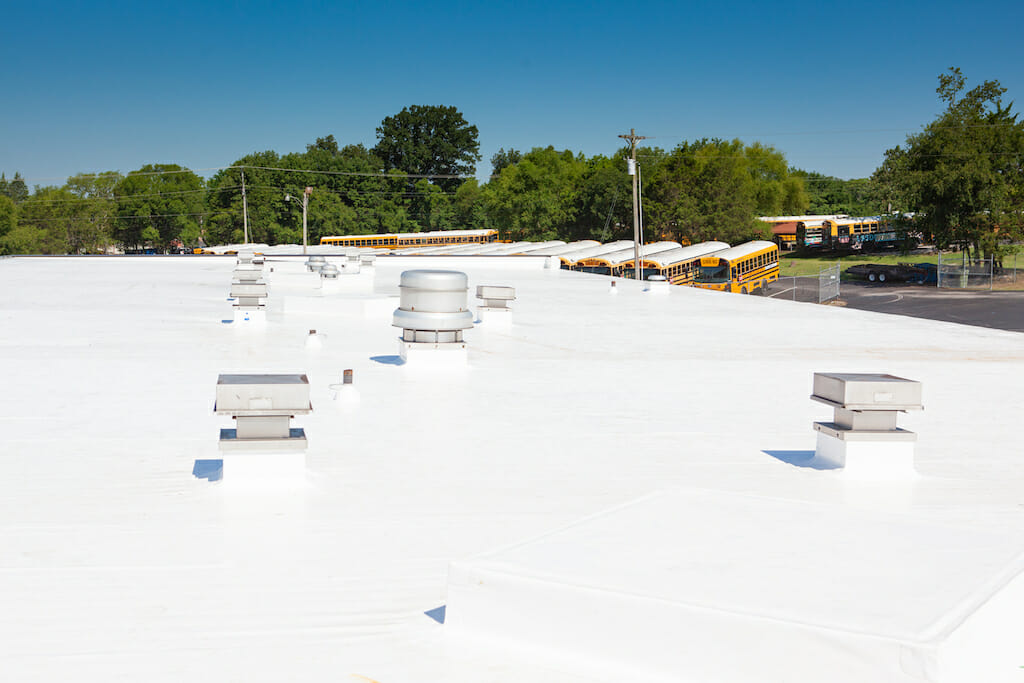When planning to install or repair a low-slope roof on your commercial building, you want to ensure that you’re planning for longevity. By not cutting corners and checking for quality along the way, your roofing contractor can significantly improve the lifespan of your roofing investment. To help you identify whether your commercial roofing partner is following best practices, here are eight common low-slope roofing mistakes they should avoid.
1. Having Inadequate Drainage
Proper drainage is essential to keep your roof free of pooling water and the accumulation of dirt and debris. Drainage issues are especially common in low-slope roofs, often causing long-term water damage. Among other consequences, poor drainage and pooling water can dissolve the adhesives used in construction, allowing moisture to infiltrate your building. Your roofing contractor should design a plan to prevent drainage issues before beginning your project.
2. Using Low-Quality or Incorrect Materials
As water does not drain as quickly from a low-slope roof due to its lack of slant, the materials your roofer chooses are important to ensure its longevity. You must consider that water will pool, even briefly, and so the materials must be able to withstand that exposure. Additionally, in the colder months, pooling water can freeze and thaw, so temperature should also be taken into account when searching for the best materials.
3. Failing to Check the Seams Throughout the Project
Rather than waiting until the end of a project to check the seams, your roofer should probe the seams throughout the project to identify gaps. A “probe” is a tool that a roofer uses to test the welded seams of your roof. Checking the seams as they go will prevent issues from arising in the roofing inspection or—if gaps are overlooked by an inspector—causing damage to your roof down the line.
4. Improper Repairs
You’ve invested a lot of money in a new roof system, but small repairs are bound to happen throughout the years. Be sure to utilize a high-quality roofing contractor with experience and manufacturer approval so that warrantable repairs are made. Incorrect products or improper repairs can actually cause more harm than good to a new roof system.
5. Reactive Maintenance
A low-slope roof system needs to be regularly inspected and maintained to prevent small leaks from becoming larger issues. Many owners and representatives expect a new roof system to be water-tight and problem-free, but roofs are exposed to weather conditions and other external factors that can cause damage to a roof system. To avoid common issues, proactively manage your roof system with annual assessments and regularly scheduled preventative maintenance calls.
6. Leaving the Membrane Dirty
To ensure proper welding, adhering, or mechanical fastening, your roofer should ensure that the roof’s membrane is clean and dry beforehand. Even when returning to a roof for patches or repairs, cleaning the membrane should always be done first. When bonding new patches, flashing, or new membrane to the original field membrane, it must be as clean as possible for a long-term seal. The older the original material, the more difficult this is to do properly because the membrane naturally deteriorates over time.
7. Placing T-Joint Patches Incorrectly
A t-joint is where layers of a roof’s membrane meet. For leak prevention, t-joint patches must be placed and appropriately welded throughout the roofing system. Your roofer must cover all three of the joint’s membranes with the patch. And it’s equally important that they put the patches in the necessary places.
8. Improper Workmanship
For a high-quality roof system, hire a knowledgeable roofer. Many common roof problems can be traced to poor workmanship, so to minimize the risk of future roof problems, use an experienced and established roofing contractor. Professional roofing companies train their employees with proper installation techniques and high-quality products. To help avoid poor workmanship, always research the roofing contractor prior to hiring for their reputation, longevity, and safety rating. By taking the time upfront to choose carefully, you can minimize the risk for post-installation issues.
Contact Maxwell Roofing & Sheet Metal, Inc. today to learn how we can make your low-slope roof last longer with regular inspections and maintenance.

